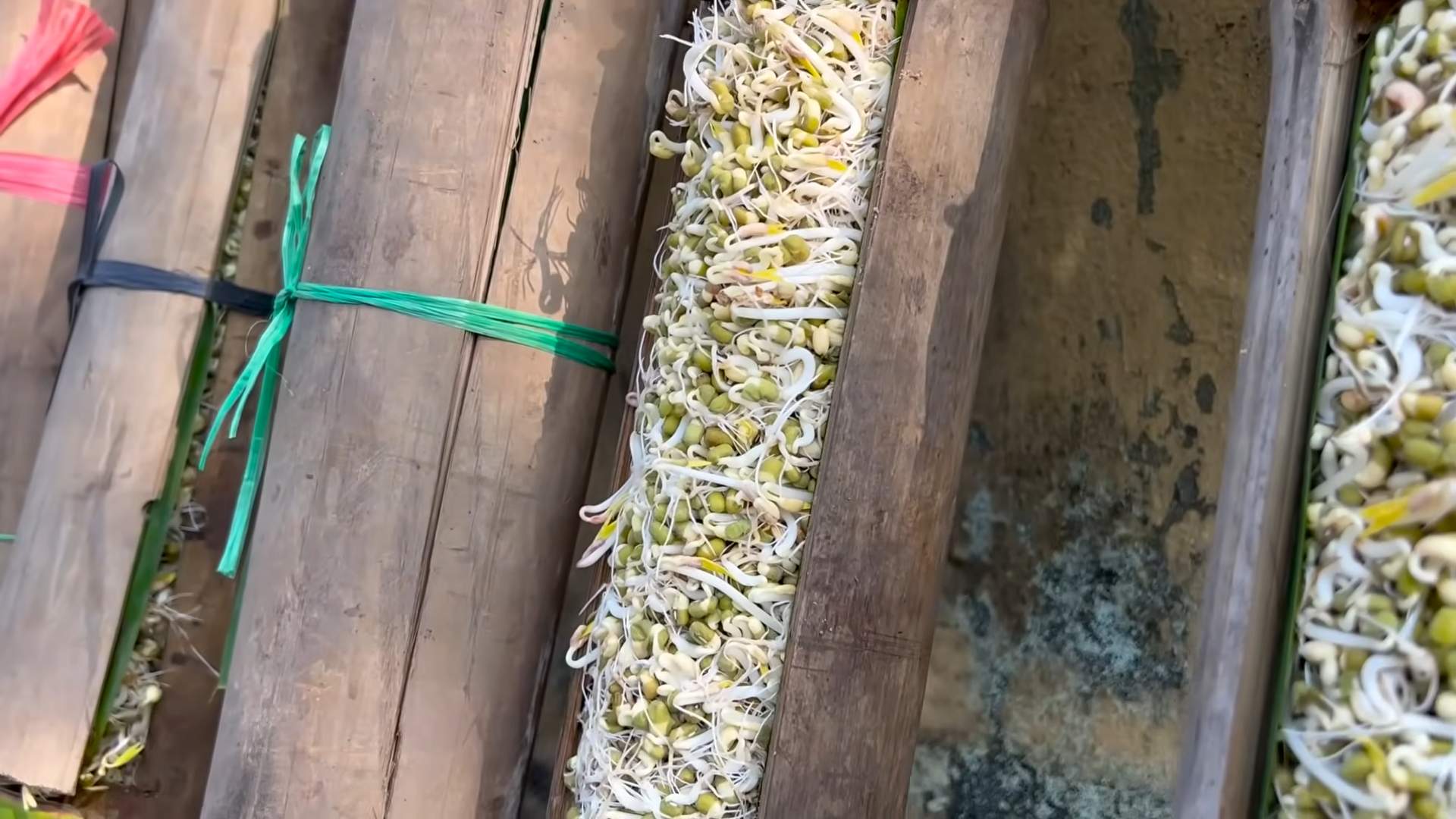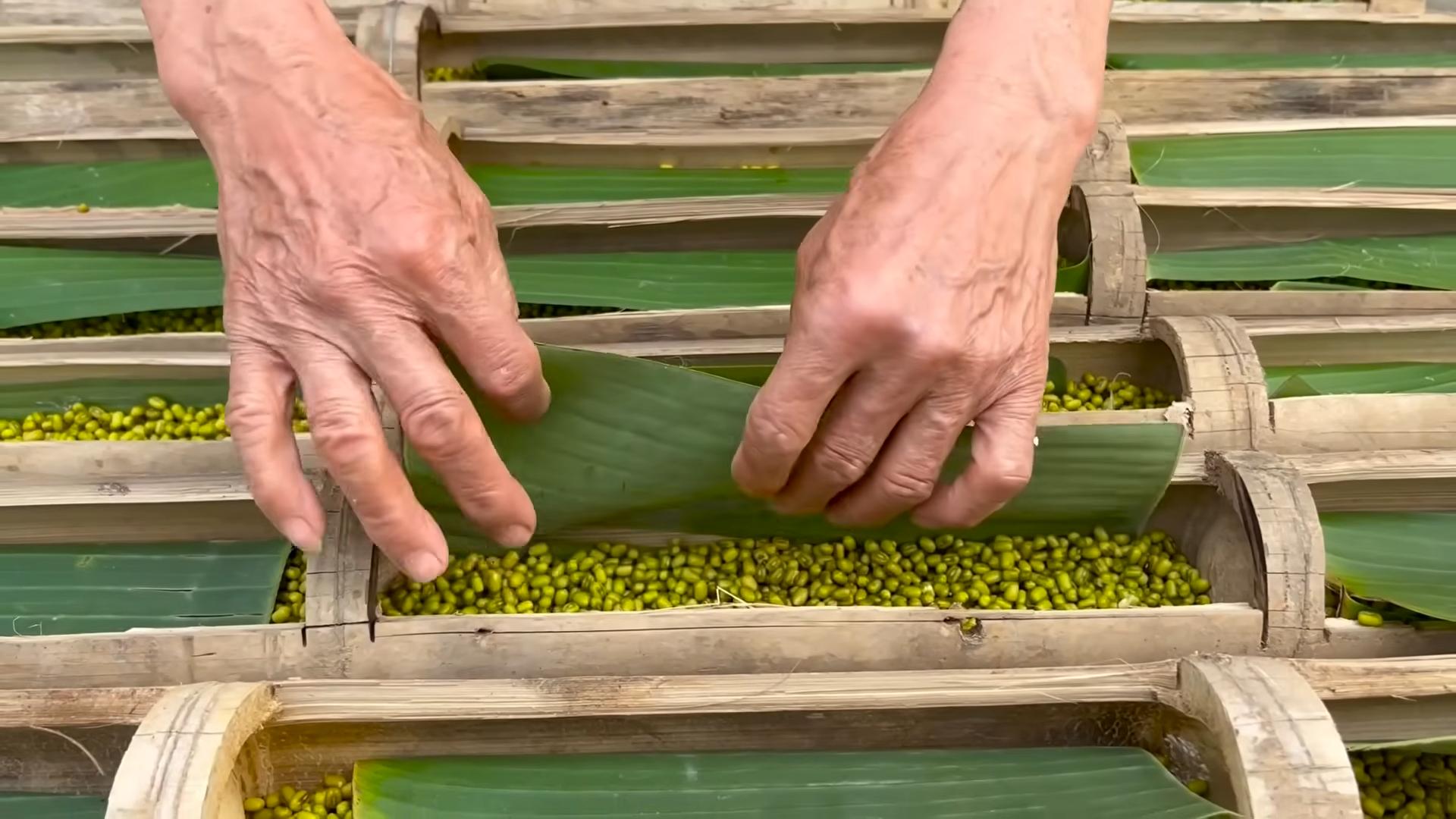Grow Bean Sprouts Easily, right in your kitchen! Forget those expensive trips to the grocery store for fresh sprouts. I’m going to show you how to cultivate these nutritional powerhouses with minimal effort and maximum flavor. For centuries, bean sprouts have been a staple in Asian cuisine, prized not only for their crunchy texture and delicate taste but also for their impressive health benefits. From stir-fries to salads, they add a delightful freshness to any dish.
But why should you learn to grow bean sprouts easily at home? Well, store-bought sprouts can sometimes be a gamble. You never quite know how fresh they are or if they’ve been properly handled. By growing your own, you have complete control over the process, ensuring a safe, healthy, and delicious addition to your meals. Plus, it’s incredibly satisfying to watch those tiny seeds transform into vibrant sprouts in just a few days! This DIY project is perfect for beginners, requires minimal space, and is a fantastic way to add a touch of green to your indoor environment, especially during the colder months. So, let’s dive in and unlock the secrets to sprouting success!

Grow Bean Sprouts Easily at Home: A Step-by-Step Guide
Hey there, fellow DIY enthusiasts! I’m super excited to share one of my favorite and easiest DIY projects with you: growing your own bean sprouts! It’s incredibly rewarding, surprisingly fast, and adds a fresh, crunchy element to your salads, stir-fries, and sandwiches. Plus, it’s a fantastic way to get some extra nutrients into your diet. Let’s dive in!
What You’ll Need
Before we get started, let’s gather all the necessary supplies. Don’t worry, you probably already have most of these lying around your kitchen!
* **Bean Seeds:** Mung beans are the most common and easiest to sprout, but you can also use adzuki beans, lentils, chickpeas, or even soybeans. Just make sure they are specifically labeled for sprouting or are intended for cooking (not treated with chemicals). I usually get mine from the bulk section of my local health food store.
* **A Wide-Mouthed Jar:** A quart-sized mason jar works perfectly. You can also use a large glass bowl if you prefer.
* **Sprouting Lid or Cheesecloth:** You’ll need something to cover the jar and allow for drainage. Sprouting lids are specifically designed for this purpose and are super convenient. If you don’t have one, a piece of cheesecloth secured with a rubber band will work just as well.
* **Water:** Clean, filtered water is best.
* **A Dark Place:** Bean sprouts need darkness to germinate properly. A cupboard, pantry, or even a covered box will do the trick.
* **A Colander or Strainer:** For rinsing the sprouts.
* **Optional: A Sprout Stand:** This isn’t essential, but it helps with drainage and airflow. You can easily make one by tilting the jar at an angle in a bowl.
Step-by-Step Instructions: Sprouting Success!
Okay, now for the fun part! Follow these steps, and you’ll be enjoying your own homegrown bean sprouts in no time.
1. **Rinse the Beans:** Place about 1/4 to 1/2 cup of bean seeds in your jar. I usually start with 1/4 cup, as they expand quite a bit during sprouting. Rinse them thoroughly with cool water, removing any debris or damaged beans. This step is crucial for preventing mold growth.
2. **Soak the Beans:** Fill the jar with cool water, ensuring the beans are completely submerged. They’ll absorb a lot of water during this process. Cover the jar with your sprouting lid or cheesecloth and secure it with a rubber band. Let the beans soak for 8-12 hours, or even overnight. I usually soak them before I go to bed, so they’re ready to go in the morning.
3. **Drain and Rinse (Again!):** After soaking, drain the water completely through the sprouting lid or cheesecloth. Rinse the beans thoroughly with fresh, cool water. This is super important to keep them hydrated and prevent them from drying out.
4. **Darkness is Key:** Place the jar in a dark, well-ventilated place. I use my kitchen cupboard. Make sure the jar is tilted at an angle (using a sprout stand or propped up in a bowl) to allow for proper drainage. This prevents the beans from sitting in water, which can lead to spoilage.
5. **Rinse and Drain (Twice a Day!):** This is the most important step! Rinse and drain the beans thoroughly with fresh, cool water at least twice a day – morning and evening. This keeps them moist and prevents mold growth. I usually do it more often if I remember.
6. **Observe the Magic:** After a day or two, you’ll start to see tiny sprouts emerging from the beans. This is so exciting! Continue rinsing and draining twice a day, keeping the jar in the dark.
7. **Introduce to Light (Optional):** After about 3-4 days, when the sprouts are about an inch or two long, you can optionally expose them to indirect sunlight for a day or two. This will help them develop chlorophyll and turn a light green color. I personally like the slightly bitter taste of the green sprouts, but it’s totally up to you!
8. **Harvest Time!:** Your bean sprouts are ready to harvest when they reach your desired length, usually around 4-7 days. I prefer mine when they are about 2-3 inches long.
9. **Final Rinse and Storage:** Give the sprouts a final rinse in a colander to remove any remaining hulls. Gently pat them dry with a clean towel. Store them in a sealed container in the refrigerator. They should last for about a week.
Troubleshooting: Common Issues and Solutions
Even with the best intentions, sometimes things can go wrong. Here are some common issues you might encounter and how to fix them:
* **Mold Growth:** This is usually caused by insufficient rinsing or poor drainage. If you see any mold, discard the entire batch. To prevent mold, make sure you’re rinsing thoroughly at least twice a day and that the jar is tilted for proper drainage.
* **Slow Sprouting:** This could be due to several factors, including old seeds, low temperatures, or insufficient moisture. Make sure your seeds are fresh and that you’re rinsing them regularly. You can also try placing the jar in a slightly warmer location.
* **Unpleasant Odor:** This is usually a sign of bacterial growth. Discard the batch and start over, paying extra attention to rinsing and drainage.
* **Dry Sprouts:** If your sprouts are drying out, you’re probably not rinsing them often enough. Increase the frequency of rinsing, especially in dry climates.
Tips and Tricks for Sprouting Success
Here are a few extra tips to help you grow the best bean sprouts ever:
* Use fresh, high-quality seeds. Older seeds may have a lower germination rate.
* Don’t overcrowd the jar. Start with a smaller amount of beans and increase the quantity as you gain experience.
* Maintain good hygiene. Wash your hands thoroughly before handling the sprouts.
* Experiment with different types of beans. Each type has a unique flavor and texture.
* Enjoy your homegrown sprouts! Add them to salads, stir-fries, sandwiches, or enjoy them as a healthy snack.
Cleaning Up: Keeping Things Fresh
After each batch of sprouts, it’s important to thoroughly clean your jar and sprouting lid or cheesecloth. Wash them with hot, soapy water and rinse well. You can also sanitize them with a diluted bleach solution (1 tablespoon of bleach per gallon of water). This will help prevent the growth of bacteria and mold in future batches.
Why Grow Your Own Bean Sprouts?
Besides being a fun and rewarding project, growing your own bean sprouts offers several benefits:
* Freshness: Homegrown sprouts are much fresher than store-bought ones.
* Cost-Effective: Sprouting your own beans is significantly cheaper than buying them at the store.
* Nutritious: Bean sprouts are packed with vitamins, minerals, and enzymes.
* Sustainable: Growing your own sprouts reduces your carbon footprint.
* Control: You have complete control over the growing process, ensuring that your sprouts are free from pesticides and other harmful chemicals.
Different Bean Varieties: A World of Sprouts
While mung beans are the most common choice for sprouting, don’t be afraid to experiment with other varieties! Here are a few of my favorites:
* Adzuki Beans: These have a slightly nutty flavor and a reddish-brown color.
* Lentils: Lentil sprouts are quick to grow and have a mild, earthy flavor.
* Chickpeas: Chickpea sprouts are larger and have a slightly crunchy texture.
* Soybeans: Soybean sprouts are rich in protein and have a slightly bitter flavor.
Remember to adjust the soaking and sprouting times based on the specific type of bean you’re using.
Sprout Recipes: Delicious Ways to Enjoy Your Harvest
Now that you have a bounty of fresh bean sprouts, it’s time to get creative in the kitchen! Here are a few of my favorite ways to use them:
* Salads: Add bean sprouts to your favorite salads for a crunchy and nutritious boost.
* Stir-Fries: Bean sprouts are a classic addition to stir-fries, adding a delightful crunch and subtle flavor.
* Sandwiches: Layer bean sprouts on your sandwiches for added texture and nutrients.
* Spring Rolls: Bean sprouts are a key ingredient in fresh spring rolls.
* Soups: Add bean sprouts to soups just before serving for a fresh and crunchy garnish.
I hope you found this guide helpful and inspiring! Growing your own bean sprouts is a simple and rewarding way to add fresh, nutritious food to your diet. So, grab some beans, a jar, and get sprouting! Happy growing!

Conclusion
So, there you have it! Growing your own bean sprouts at home is not only incredibly easy, but it’s also a rewarding experience that puts fresh, nutritious ingredients right at your fingertips. Forget those limp, pre-packaged sprouts from the grocery store. With this simple DIY trick, you can cultivate vibrant, crunchy bean sprouts bursting with flavor and packed with vitamins and minerals.
The beauty of this method lies in its simplicity and adaptability. You don’t need any fancy equipment or specialized knowledge. Just a jar, some beans, water, and a little patience. The savings alone make this a worthwhile endeavor, but the superior taste and freshness are what will truly win you over. Imagine adding a handful of your own homegrown bean sprouts to your salads, stir-fries, sandwiches, or even enjoying them as a healthy snack. The possibilities are endless!
Beyond the basic method, there’s plenty of room for experimentation. Try using different types of beans, such as mung beans (the most common), adzuki beans, or even lentils, to discover your favorite flavor profile. You can also adjust the sprouting time to achieve your desired sprout length and texture. Some people prefer shorter, crunchier sprouts, while others prefer longer, more developed ones. Don’t be afraid to play around and find what works best for you.
Consider adding a touch of flavor during the rinsing process. A splash of lemon juice or a pinch of sea salt can enhance the taste of your bean sprouts and add a subtle complexity. You can also experiment with different sprouting environments. Some people find that a slightly warmer temperature encourages faster growth, while others prefer a cooler environment for a more controlled process.
This DIY trick for growing bean sprouts is a must-try for anyone looking to add a healthy and delicious element to their diet. It’s a sustainable, cost-effective, and incredibly satisfying way to enjoy fresh produce year-round.
We wholeheartedly encourage you to give this method a try. Once you experience the joy of harvesting your own bean sprouts, you’ll never go back to store-bought again. And don’t forget to share your experiences with us! We’d love to hear about your successes, your variations, and any tips or tricks you discover along the way. Post your photos and stories on social media using [Your Hashtag Here] and let’s inspire others to embrace the wonderful world of home-grown bean sprouts. Happy sprouting!
Frequently Asked Questions (FAQ)
What types of beans can I use to grow bean sprouts?
The most common and readily available bean for sprouting is the mung bean. However, you can also successfully sprout adzuki beans, lentils, chickpeas, and even soybeans. Keep in mind that different beans will have different sprouting times and flavor profiles. Mung beans tend to have a mild, slightly sweet flavor, while adzuki beans have a nuttier taste. Experiment to find your favorite! Avoid using kidney beans or other beans that are known to be toxic when raw; these require thorough cooking to be safe for consumption.
How long does it take to grow bean sprouts?
Generally, it takes between 3 to 5 days to grow bean sprouts to a desirable length. The exact time will depend on the type of bean, the temperature, and the humidity. Mung beans typically sprout within 3 to 4 days, while other beans may take a day or two longer. Keep an eye on your sprouts and harvest them when they reach your preferred size.
How often should I rinse the bean sprouts?
Rinsing is crucial for preventing mold and bacteria growth. You should rinse your bean sprouts at least twice a day, ideally three times a day, with fresh, cool water. Make sure to drain the water thoroughly after each rinse. This helps to keep the sprouts hydrated and prevents them from drying out.
What if my bean sprouts start to smell bad?
A foul odor is a sign of bacterial contamination. If your bean sprouts start to smell bad, it’s best to discard them. This usually happens if the sprouts are not rinsed frequently enough or if the sprouting environment is too warm and humid. To prevent this, ensure you are rinsing the sprouts regularly and that the jar is well-ventilated.
How do I store bean sprouts?
Once your bean sprouts have reached your desired length, you can store them in the refrigerator for up to a week. To store them, rinse them thoroughly and drain them well. Place them in a clean container lined with a paper towel to absorb excess moisture. This will help to keep them fresh and crisp.
Can I eat the bean sprout roots?
Yes, the roots of bean sprouts are perfectly edible. They are a natural part of the sprouting process and are safe to consume. Some people even prefer the taste and texture of the roots.
Why are my bean sprouts not growing?
There could be several reasons why your bean sprouts are not growing. First, make sure that the beans you are using are fresh and viable. Old beans may not germinate properly. Second, ensure that the beans are being rinsed regularly and that the sprouting environment is not too hot or too cold. Third, make sure that the beans are not exposed to direct sunlight, as this can inhibit growth.
Can I grow bean sprouts in direct sunlight?
No, bean sprouts should not be grown in direct sunlight. Direct sunlight can overheat the sprouts and inhibit their growth. It can also cause them to turn bitter. The ideal sprouting environment is dark and well-ventilated.
Are there any health benefits to eating bean sprouts?
Yes, bean sprouts are a nutritional powerhouse. They are a good source of vitamins, minerals, and antioxidants. They are also low in calories and high in fiber. Eating bean sprouts can help to boost your immune system, improve digestion, and protect against chronic diseases.
Can I use tap water to grow bean sprouts?
While tap water is generally safe, it’s best to use filtered water for growing bean sprouts. Tap water can contain chlorine and other chemicals that may inhibit growth or affect the taste of the sprouts. Filtered water will provide a cleaner and more consistent environment for sprouting.
How do I prevent mold from growing on my bean sprouts?
The key to preventing mold growth is to rinse the bean sprouts regularly and ensure that the sprouting environment is well-ventilated. Mold thrives in warm, humid conditions, so keeping the sprouts clean and dry is essential. If you notice any signs of mold, discard the affected sprouts immediately.
What is the best temperature for growing bean sprouts?
The ideal temperature for growing bean sprouts is between 70°F and 80°F (21°C and 27°C). This temperature range provides the optimal conditions for germination and growth. Avoid exposing the sprouts to extreme temperatures, as this can inhibit growth or cause them to spoil.




Leave a Comment